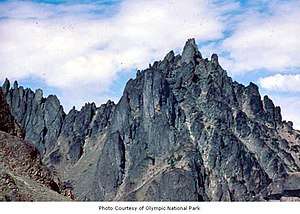Mount Clark (Washington)
Mount Clark is a 7,528-foot (2,295-metre) mountain summit located within Olympic National Park in Jefferson County of Washington state.[2] Its nearest higher peak is Sweat Spire (6847 ft) on Mount Johnson, 0.26 mi (0.42 km) to the southwest, and Mount Walkinshaw is set 0.9 mi (1.4 km) to the north.[1] It is the second highest peak in The Needles range, which is a subrange of the Olympic Mountains, and seventh highest in the Olympic Mountains.[4] The climbing routes on Mt. Clark start at Class 3 scrambling and range up to Class 5.5 via the central South Face.[3] Precipitation runoff from the mountain drains into tributaries of the Dungeness River.
| Mount Clark | |
|---|---|
 | |
| Highest point | |
| Elevation | 7,528 ft (2,295 m) [1] |
| Prominence | 608 ft (185 m) [1] |
| Coordinates | 47°50′08″N 123°13′54″W [2] |
| Geography | |
 Mount Clark Location of Mount Clark in Washington  Mount Clark Mount Clark (the United States) | |
| Location | Olympic National Park Jefferson County, Washington, United States |
| Parent range | Olympic Mountains |
| Topo map | USGS Mount Deception |
| Geology | |
| Age of rock | Eocene |
| Type of rock | basalt |
| Climbing | |
| Easiest route | Scrambling YDS 3 [3] |
History
The first ascent of the mountain was made on August 21, 1940 by George R. Martin and Elvin Johnson who dubbed the peak Mt. Belvedere.[5]
The mountain was officially named in 1965 to honor Irving M. Clark (1882-1960), a Seattle conservationist and leader in the establishment of Olympic National Park.[5]
Climate
Based on the Köppen climate classification, Mount Clark is located in the marine west coast climate zone of western North America.[6] Most weather fronts originate in the Pacific Ocean, and travel northeast toward the Olympic Mountains. As fronts approach, they are forced upward by the peaks of the Olympic Range, causing them to drop their moisture in the form of rain or snowfall (Orographic lift). As a result, the Olympics experience high precipitation, especially during the winter months. During winter months, weather is usually cloudy, but, due to high pressure systems over the Pacific Ocean that intensify during summer months, there is often little or no cloud cover during the summer. In terms of favorable weather, the best months for climbing are June through September.
References

- "Mount Clark". Peakbagger.com.
- "Mount Clark". Geographic Names Information System. United States Geological Survey. Retrieved 2019-01-21.
- Mount Clark at Climbers Guide Olympics
- Peakbagger Olympic Mountain 6500-foot Peaks
- Parratt, Smitty (1984). Gods and Goblins: A Field Guide to Place Names of Olympic National Park (1st ed.).
- Peel, M. C.; Finlayson, B. L. & McMahon, T. A. (2007). "Updated world map of the Köppen−Geiger climate classification". Hydrol. Earth Syst. Sci. 11: 1633–1644. ISSN 1027-5606.
External links
- "Olympic National Park". National Park Service.
- Mount Clark weather: Mountain Forecast